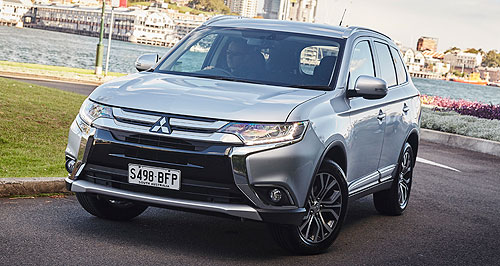News - MitsubishiMitsubishi announces multiple recallsTotal recall: All of the Mitsubishi i-MiEVs sold in Australia in 2010 and 2012 are being recalled as part of an extensive recall that extends to more than 400,000 vehicles nationwide. Seven simultaneous recall notices effects about 400,000 Mitsubishi vehicles30 Jun 2016 MITSUBISHI is recalling about 400,000 Australian-spec vehicles as part of a rare multiple-case notification that effects seven different models and seven separate potential faults. The car-maker's local arm has identified 429,981 Australian cases requiring inspection and the possibility of remedial work, but as some owner's cars may be effected by more than one of the multiple recalls, the number of necessary recalls is likely to be lower. While simultaneous recall notices do sometimes occur, it is unusual for such a large number to be issued at once, but Mitsubishi Motors Australia Limited product communications manager John Taylor said a combination of necessary “data collation, translation and coincidence” was responsible for the simultaneous issue. Mr Taylor explained that vehicles requiring attention for more than one recall can have all work completed in a single visit to a Mitsubishi dealership, and while the Australian network was bracing for increased traffic, many dealerships would appreciate the opportunity to build business. “The dealerships have to resource up and they get help from us so they can manage the massive amount of phone calls,” he said. “The dealerships treat them (recalls) as a good chance to get in contact with potentially second owners. It's a good opportunity for our guys at head office to chase down the owners so there are positives in there as well.” Of the numerous potential faults rolling around in Mitsubishi models, Mr Taylor confirmed that “there have been no confirmed incidents/accidents or injuries relating to any of these recalls”. The most widespread of the recalls concerns the possibility of a defective indicator switch and 383,379 vehicles, including the Challenger, Outlander, Pajero and Triton off-roaders, the Lancer sedan and Sportback as well as the i-MiEV electric city car. According to the official alert on the Australian Competition and Consumer Commission (ACCC) product recalls website, faulty indicator stalks have the potential to develop oxidised electrical terminals, which in turn can cause the turn signal, headlights, parking lights, fog, registration plate and tail-light to fail. Where necessary, the remedial work to replace faulty components will take approximately 30 minutes. The second of the recall notices concerns the body systems control module of 44,585 model year 2009 and 2010 Lancer sedan, Lancer Sportback and Outlander models. An incorrect manufacturing process has the potential to cause an unstable voltage in the control unit, which could lead to the failure of the headlights and/or windscreen wipers. Replacement of the ECU should take about one hour. A power steering electrical fault in model year 2011 Mitsubishi Colt vehicles may cause the power assistance to be interrupted under certain circumstances, creating the potential hazard of increased steering weight. Up to 1513 vehicles may have the potential for the problem and rectification of faulty components should take about two hours. In addition to the more widespread indicator stalk recall, the Japanese car-maker's i-MiEV tiny electric car is effected by up to a further three potential problems. A potential brake servo vacuum pump defect covers 237 of model year 2010 and 1012 i-MiEVs sold in Australia, which under certain environmental conditions can cause corrosion of the pump exhaust, leading to its failure and a reduction of braking assistance from the servo. Of the 237 vehicles recalled, Mitsubishi reports that 160 will require a 30-minute reprogram of the main drive ECU, while replacement of the vac pump should take approximately one hour. The third recall for the i-MiEV effects just 37 examples Australia-wide and concerns the motor control unit, which may need to be replaced for an unspecified fault, adding another 90 minutes to the potential workshop time. In the case of 85 Lancer Evo 10s and 90 Lancer Ralliart models, a handbrake cable contacting the fuel tank could remove the anti-corrosion coating causing a rust hole and a potential fuel leak. Replacing the offending cable will take 90 minutes, while the replacement of a damaged tank will double the time required to repair. The final recall covers just 55 model year 2016 Outlander SUVs excluding the plug-in hybrid version. When an original equipment trailer brake accessory is used, an incorrectly redesigned wiring harness will prevent the auxiliary trailer brakes and brake lights from operating. If the trailer brakes are inoperable, the extra force applied to the towing vehicle could cause a hazardous situation. In all cases, Mitsubishi will be contacting the last registered owners of affected vehicles to arrange inspection appointments at Mitsubishi service centres, but customers can find out if their vehicle is impacted by visiting the ACCC website recalls.gov.au for a full list of impacted vehicle chassis numbers and model years.  Read more |
Click to shareMitsubishi articlesResearch Mitsubishi Motor industry news |

















Facebook Twitter Instagram